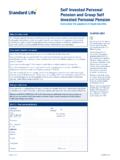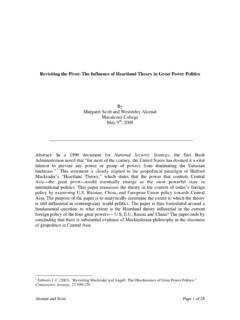Transcription of Obesity and inequities - World Health Organization
1 Obesity and inequities Guidance for addressing inequities in overweight and Obesity Obesity and inequities Guidance for addressing inequities in overweight and Obesity Written by: Belinda Loring Aileen Robertson Abstract This policy guidance aims to support European policy-makers to improve the design, implementation and evaluation of interventions and policies to reduce inequities in overweight and Obesity . The prevalence of Obesity in Europe is rising in many countries, and rising fastest in low socioeconomic population groups. There is a strong relationship between Obesity and low socioeconomic status, especially for women. Reducing Health inequities is a key strategic objective of Health 2020 the European policy framework for Health and well-being endorsed by the 53 Member States of the WHO European Region in 2012.
2 This guide seeks to assist European policy-makers in contributing to achieving the objectives of Health 2020 in a practical way. It draws on key evidence, including from the Review of social determinants and the Health divide in the WHO European Region. It sets out options to reduce the unequal distribution of Obesity in Europe, through approaches which address the social determinants of Obesity and the related Health , social and economic consequences of the Obesity inequity gradient. Keywords Health POLICY. Obesity . OVERWEIGHT. SOCIAL DETERMINANTS OF Health . SOCIOECONOMIC FACTORS. Address requests about publications of the WHO Regional Office for Europe to: Publications WHO Regional Office for Europe UN City, Marmorvej 51. DK-2100 Copenhagen , Denmark Alternatively, complete an online request form for documentation, Health information, or for permission to quote or translate, on the Regional Office website ( ).
3 ISBN 978 92 890 5048 7. World Health Organization 2014. All rights reserved. The Regional Office for Europe of the World Health Organization welcomes requests for permission to reproduce or translate its publications, in part or in full. The designations employed and the presentation of the material in this publication do not imply the expression of any opinion whatsoever on the part of the World Health Organization concerning the legal status of any country, territory, city or area or of its authorities, or concerning the delimitation of its frontiers or boundaries. Dotted lines on maps represent approximate border lines for which there may not yet be full agreement. The mention of specific companies or of certain manufacturers' products does not imply that they are endorsed or recommended by the World Health Organization in preference to others of a similar nature that are not mentioned.
4 Errors and omissions excepted, the names of proprietary products are distinguished by initial capital letters. All reasonable precautions have been taken by the World Health Organization to verify the information contained in this publication. However, the published material is being distributed without warranty of any kind, either express or implied. The responsibility for the interpretation and use of the material lies with the reader. In no event shall the World Health Organization be liable for damages arising from its use. The views expressed by authors, editors, or expert groups do not necessarily represent the decisions or the stated policy of the World Health Organization . Edited by Nicole Satterley Book design by Marta Pasqualato Printed by AREAGRAPHICA SNC DI TREVISAN GIANCARLO & FIGLI.
5 Cover: S. Barrag n | World Health Organization Contents Acknowledgements and contributions iv Foreword v Introduction 1. Purpose of this guidance 1. Using this guide 2. Relevance to other key goals 2. inequities in Obesity -related harm in Europe 3. What can be done? 7. Step-wise approach 8. First do no harm 8. Policy interventions at different levels 9. Socioeconomic context and position 13. Differential exposures 16. Differential vulnerabilities 16. Differential Health outcomes 20. Differential consequences 21. Where to find out more 27. Policy options for addressing Obesity 27. Actions to reduce Health inequities through action on SDH 27. Policy equity assessment tools 28. Data disaggregation and tools 28. References 29. iii Acknowledgements and contributions This document was written by Belinda Loring, WHO European Office for Investment for Health and Development, Venice, Italy, and Aileen Robertson, WHO Collaborating Centre for Global Nutrition and Health , Metropolitan University College, Copenhagen, Denmark.
6 The following people provided helpful comments and expert technical review: Jo o Breda, Erio Ziglio, Piroska Ostlin, sa Nihl n, Chris Brown, Francesco Zambon, and Sara Barrag n Montes, WHO Regional Office for Europe Margaret Whitehead, WHO Collaborating Centre for Policy Research on Social Determinants of Health , University of Liverpool, Liverpool, United Kingdom Sue Povall, WHO Collaborating Centre for Policy Research on Social Determinants of Health , University of Liverpool, Liverpool, United Kingdom Pedro Gra a, Directorate-General of Health , Lisbon, Portugal Chris Brookes, UK Health Forum, London, United Kingdom Charles Price, European Commission Directorate-General for Health & Consumers, Brussels, Belgium Nabil Safrany, European Commission Executive Agency for Health and Consumers, Luxembourg.
7 Further comments were also provided by the European Commission Directorate- General for Health & Consumers, the Executive Agency for Health and Consumers and the European Union Expert Group on Health Inequalities. This document has been produced with the financial assistance of the European Union. The views expressed herein can in no way be taken to reflect the official opinion of the European Union. The WHO European Office for Investment for Health and Development of the WHO. Regional Office for Europe also wishes to thank the Italian Ministry of Health , the Veneto Region and the Tuscany Region for their long-standing support to the work of the office as well as the financial support for this publication. iv Foreword Overall population Health indicators have improved across Europe over recent decades, yet that improvement has not been experienced equally everywhere, or by all.
8 There are widespread inequities in Health between and within societies, reflecting the different conditions in which people live. These Health inequities offend against the human right to Health and are unnecessary and unjust. Health 2020 is a new value- and evidence-based Health policy framework for Europe, supporting action across government and society to promote Health and well-being, the reduction of Health inequities and the pursuit of people-centred Health systems. It was adopted at the 62nd session of the Regional Committee held in Malta in September 2012. Its commitment is to Health and well-being as a vital human right, essential to human, social and economic development and a sustainable and equitable Europe. Health is a fundamental resource for the lives of people, families and communities.
9 To make this vision a reality we need to tackle the root causes of Health inequities within and between countries. We know more about these now from the 2013 report of the European review of social determinants of Health and the Health divide, led by Professor Sir Michael Marmot and his team at the University College London Institute of Health Equity. Yet opportunities to be healthy are far from being equally distributed in our countries, and are closely linked to good upbringing and education, decent work, housing and income support throughout our life course. Today's disease burden is rooted in how we address these social factors that shape current patterns of ill Health and lifestyles, and in the way our resources are distributed and utilized. For these reasons I welcome the publication of this series of policy briefs, which describe practical actions to address Health inequities , especially in relation to priority public Health challenges facing Europe: tobacco, alcohol, Obesity and injury.
10 I hope this series will offer policy-makers and public Health professionals the tools and guidance they need to implement the Health 2020 vision and the recommendations of the social determinants review. The policy briefs were prepared in collaboration with the European Union and I would like to express my gratitude for this support and for the recognition that the European Union and WHO both share this common commitment to addressing equity. Achieving the promise of Health 2020 will depend on successful implementation of the relevant policies within countries. We can and must seize new opportunities to enhance the Health and well-being of all. We have an opportunity to promote effective practices and policy innovations among those working to improve Health outcomes. The present (often extreme) Health inequities across our Region must be tackled and the Health gap among and within our European Member States reduced.












